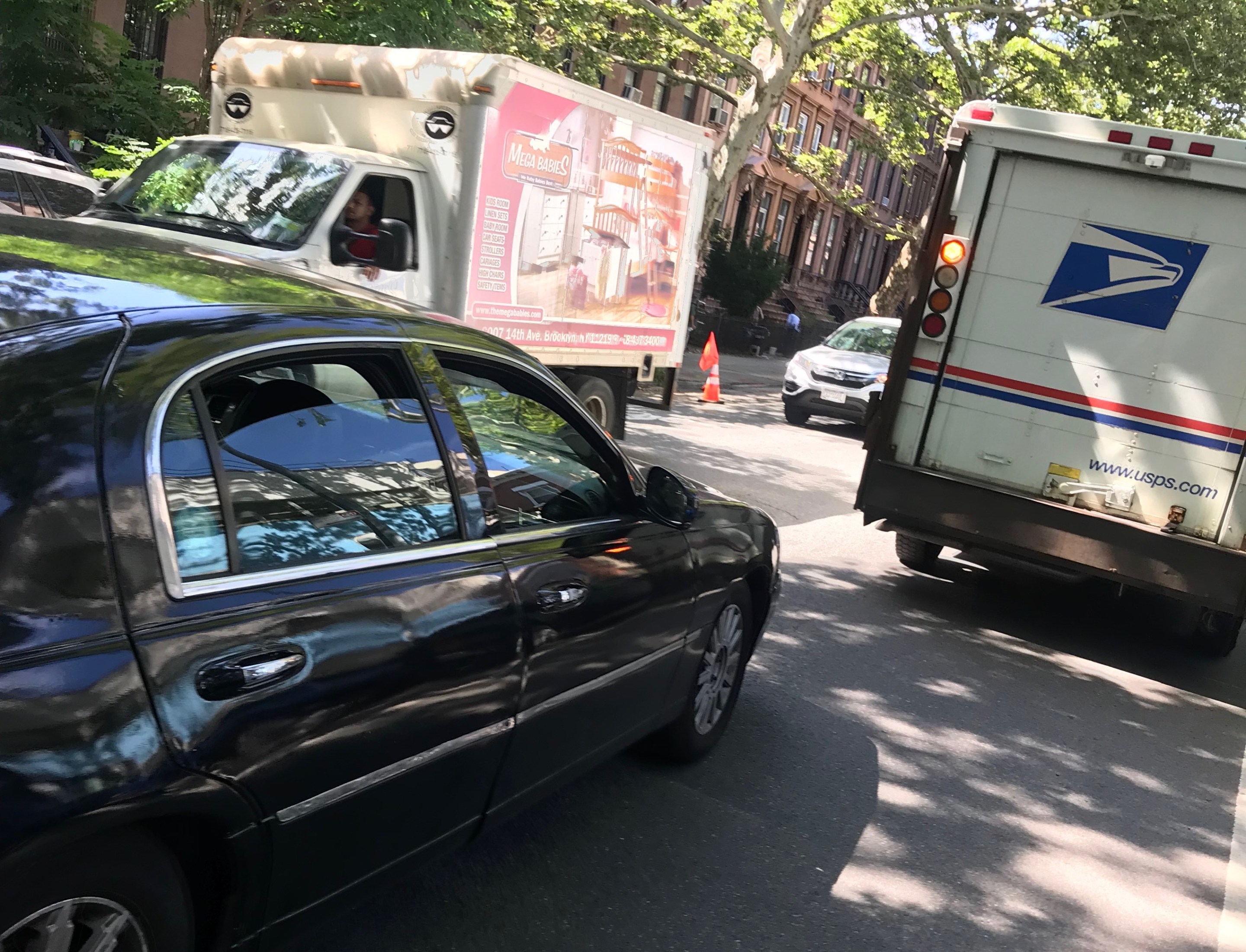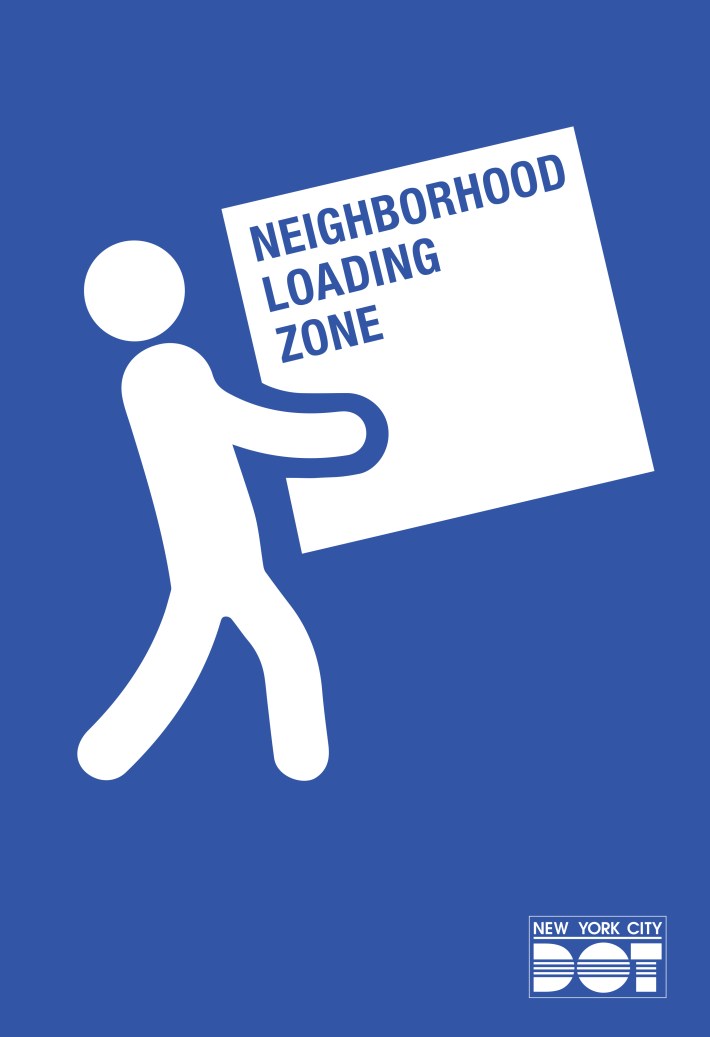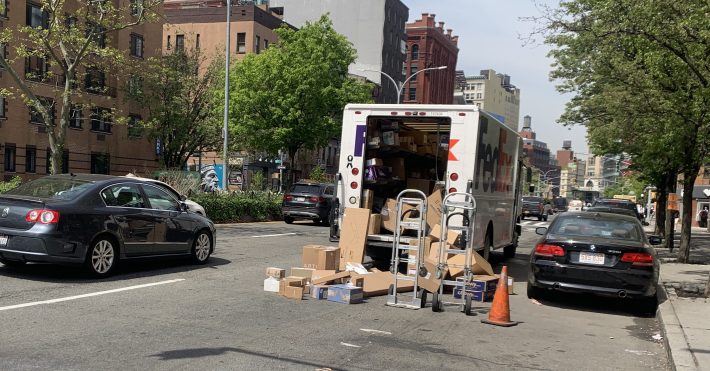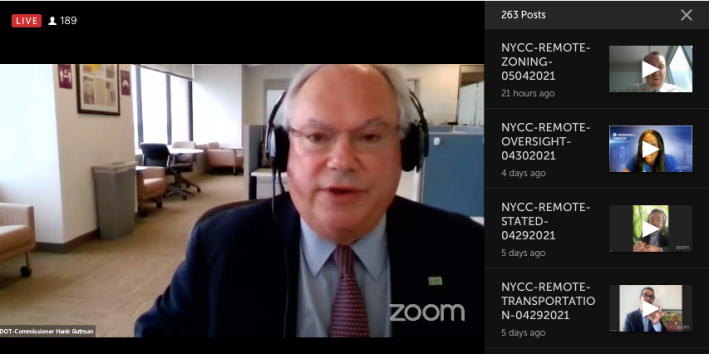DOT Pushes Back on Council Bill to Repurpose Private Parking for Public Benefit
2:41 PM EDT on May 5, 2021

Another roadway ruined by a double-parked delivery truck. File photo: Gersh Kuntzman
Loading zones are awesome — but not if we have to remove too much parking for private car owners!
Department of Transportation Commissioner Hank Gutman said the de Blasio administration strongly supports the spirit of a package of City Council bills that would "holistically" address the delivery truck crisis — but at a hearing on Wednesday, he pushed back on a specific proposal by Council Member Antonio Reynoso that would require at least 25 percent of available curb space be repurposed for loading zones in residential and commercial zones.
"Complying with the bill as drafted would require substantial repurposing of existing private passenger vehicle parking in many of these neighborhoods," Gutman said.

It was an odd response from Gutman, given his agency's consistent support for more loading zones in both residential and commercial areas. Indeed, in another portion of Gutman's testimony, he said the DOT's first-year review of its residential loading zone program revealed that double-parking on corridors with neighborhood loading zones "decreased by 10 to 70 percent." The agency now has 111 such neighborhood loading zones (each about 30 feet), which have proven successful. (For context: That number is paltry given the scale of the problem: 1.5 million packages delivered per day in a city of 6,000 miles of streets.)
It was also an odd answer, given that Gutman has also testified that by 2045 "our city will move 68 percent more freight on an already-constrained transportation network."
The Department of Transportation did not immediately answer Streetsblog's follow-up to clarify Gutman's position on whether the DOT believes, as most activists do, that removing private parking is itself a goal, as it would reduce driving and congestion. But Marco Conner DiAquoi of Transportation Alternatives testified that the Reynoso bill (Intro. 2279) is crucial given how inefficiently New York's road space is currently allocated.
Haha! Couldn’t have planned this random shot better if I paid them!! @UPS truck using one of @NYC_DOT neighborhood loading zones in Jax Heights. Just installed like 10 of them. Need many more but it’s a start! These two employees said the “love them, need more”! @StreetsblogNYC pic.twitter.com/goqKtEOzLp
— Streetfilms (1,071+ videos!) (@Streetfilms) December 28, 2020
"The way we currently use our streetscape is inequitable and is harmful to every goal that this city has set around public health, our environmental and sustainability goals, accessibility, reducing carbon emissions and Vision Zero," Conner DiAquoi said. "It's also highly inefficient: 75 percent of the roadway space is used for the movement of storage of cars, which are unused 95 percent of the time."

A spokesman for UPS testified in support of the legislation because it would provide delivery truckers space so that they would not double-park as much as they currently do.
"We believe this will make deliveries more efficient, but it will make safer streets for cyclists, pedestrians and drivers alike," said the spokesman, Axel Carrion.
The controversy over parking was a bit of controversy in an otherwise breezy hearing over the larger package of bills, which the de Blasio administration professes to support. In addition to the vast expansion of loading zones, the bills include provision that would create staging areas for cargo bike "last mile" distribution, redesign truck routes and mandate massive changes in building design to ease deliveries.
Here is the package (with links), with a further discussion below:
- Intro 2253 (Council Speaker Corey Johnson): Would create "a pilot program to establish micro-distribution centers for distributing goods via sustainable modes of transportation," such as cargo bikes.
- Intro 2277 (Keith Powers): Would require delivery trucks to pay for parking at loading zones through the installation of muni-meters, while also extending the hours for commercial vehicle parking in such loading zones from three to eight hours. The bill would also prohibit placard parking in commercial loading zones below 61st Street in Manhattan.
- Intro 2280 (Reynoso): Would require "a secure package storage area" in any new or significantly renovated residential building.
- Intro 2281 (Carlina Rivera): Would create an "Office of Sustainable Delivery Systems" and would require buildings with large truck traffic "to produce and implement a delivery and servicing plan."
- Intro 2282 (Ydanis Rodriguez): Would require a redrawing of the truck map route and, more important, would also require that DOT "implement daylighting at each intersection adjacent to the truck route network."
The administration generally supported the package, but there was some discussion on some measures that again suggested Gutman is not willing to go as far as the Council would like.
For example, he pushed back on the need for all of the daylighting required in Intro 2282.

"While daylighting is an important tool in our toolbox, it is not a one-size- fits-all solution," Gutman testified. "We have found it valuable in some places, but not in others, and it is critical that DOT retain the discretion to determine where to use it."
Conner DiAquoi strongly pushed back on that notion; indeed, he called on DOT to use national standards for daylighting corners — with open space of up to 25 feet — instead of the one parking space that DOT typically uses for clearing an intersection at the corner.
"Do not believe the notion that daylighting won’t work," he said. "Daylighting can save lives."
Gutman championed Intro 2253, but looked to the future rather than the past. The failure of the city to aggressively create cargo staging areas when it created its original cargo bike pilot program in 2019 was seen as an oversight then. Since then, the city has created only cargo bike corrals for delivery cyclists to load up at just two Whole Foods locations (one in Tribeca and one in the Village).
Though it was not brought up at the hearing on Wednesday, the Council package also includes commissioning a study from traffic expert Charles Komanoff (full disclosure: a Streetsblog contributor) to "evaluate the feasibility and benefits of charging vehicles delivering e-commerce products for time they occupy our streets and roads" — a congestion pricing plan for delivery vehicles, if you will, except that the per-minute charge is better than a simple one-time toll for entering a specific zone because it would encourage delivery companies to plan their routes better.
Komanoff was pleased to be able to put his years of research into traffic patterns to service.
"If you charge per minute, you can set the charge to be highest in the high congestion zones and lowest in the low," Komanoff said. "And it can be graduated by truck size and peak vs. off-peak. If it's three minutes in Zone 1, it gets charged the highest rate, but 10 minutes in Zone 2 could be priced less, etc."
Komanoff said his report would focus on policies that would not only cut down on traffic volumes of delivery vehicles, but also lead to pricing changes that could help brick-and-mortar stores and also delivery policies that would cut down on waste.
"It will be in the interest of Amazon and other companies to cram as many deliveries into the body of a truck as they can," he said. "Wasteful packaging will mean more trucks, which will result in higher charges. This will impose market discipline."
Gersh Kuntzman is editor in chief of Streetsblog NYC and Streetsblog USA. He also writes the Cycle of Rage column, which is archived here.
Stay in touch
Sign up for our free newsletter
More from Streetsblog New York City
Friday’s Headlines: Canal Street Follies Edition
Manhattan Borough President Mark Levine isn't happy. Plus other news.
Daylight Again: Bronx Community Board Backs Parking Ban at Intersections
The Boogie Down is down with daylighting!
Community Board Wants Protected Bike Lane on Empire Blvd.
Brooklyn Community Board 9 wants city to upgrade Empire Boulevard's frequently blocked bike lane, which serves as a gateway to Prospect Park.
The Brake: Why We Can’t End Violence on Transit With More Police
Are more cops the answer to violence against transit workers, or is it only driving societal tensions that make attacks more frequent?
Report: Road Violence Hits Record in First Quarter of 2024
Sixty people died in the first three months of the year, 50 percent more than the first quarter of 2018, which was the safest opening three months of any Vision Zero year.




